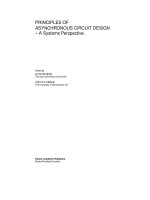Genesis of a game design pattern
Bạn đang xem bản rút gọn của tài liệu. Xem và tải ngay bản đầy đủ của tài liệu tại đây (2.67 MB, 38 trang )
Genesis of a Game Design Pattern
Game Design Patterns: a definition
“Game design patterns are general
descriptions of interaction which occur in
games. The patterns are semi-formalized
interrelated tools that can be applied in
situations to generate context-dependent
solutions. Game design patterns are usually
identified from existing games where the
interaction pattern may or may not have
been intentionally been promoted by the
game designers.”
(Björk, 2003-05-13)
A word about our pattern collection
• We have identified more that 200 patterns
• Will not be used today
– (except as examples)
– Because only ~50% are described
– None are verified enough
– Threshold to start using (you will use it at later
workshops)
Genesis of a Pattern
•
•
•
•
•
•
Recognize
Analyze
Describe
Test
Evaluate (go back to Analyze)
Outcome:
– Clear definition of the pattern
Recognize
• Patterns easy to recognize, difficult to define
• Play games, think games, dream games, design
games, read about games
• Other areas for inspiration: software engineering,
computer science, HCI, architecture, drama, myths
and legends, psychology, philosophy of mind,
choreography, music, visual arts, sociology,
human relationships, economics, politics etc. etc.
Recognize
• “Hey, there is a pattern!”
• Initial name
• Short (one or two sentences) description of the
particular example
• Sketchy example in games
• Normally patterns come in groups, networks
• Candidate collection
• More is better!
Recognize (example)
• Java thread programming -> producer-consumer model
– One thread is producing objects that the consumer
thread is gobbling up
• “Hey, this could be a game design pattern also!”
(Civilization)
• Initial name “producer-consumer”
• “One element is producing resources which another
element consumes”
• Strategy games
Recognize (example)
• Other brief ideas:
– Accumulator to store produced objects
– Limit to accumulator
– Consumer as factory -> transforms objects to
other objects
– Producer->consumer chains
– Producer->consumer networks
Recognize (where to look in games)
•
•
•
•
Tokens
Information structure
Control structure
Engagements &
Closures
• Goals
• Interaction &
Experience
• Rules
Game
Tokens
Engagements
Players/
Agents
Attributes
Info
Structure
Control
Structure
Analyze
• Analyze the group together but start with the main
candidate
• The pattern in existing games:
– Think about different genres (RTS, FPS,
MMORPG, strategy, arcade games etc.)
– Think about different kinds of games (board
and card games, children games, table-top and
live action RPGs
• Try to imagine the games without the pattern
Analyze
• List games that do not have the pattern:
– Try to find games in same genres as in the
previous list
• Compare the games from each list
– What is the difference in game play?
• How the other ideas are related to the pattern? Are
they part of it or separate?
• Relations to other patterns
Analyze (example)
• Sid Meier’s Civilization:
– Settlements produce unit
– Units consumed in combat or through new settlements
• Quake III
– Power-ups appear at spawn points
– They are consumed by players picking them up
– Players stats (health, ammo, etc.) are consumed through
activity (are players accumulators or factories?)
– Player avatars appear in spawn points and are
consumed in combat
• Tetris
– Random blocks are produced when the current block is
stopped
– Blocks are “consumed” when they stop
Analyze (example)
• Civilization without the producer-consumer
pattern?
– Would destroy the whole game
• Quake III without the pattern?
– No power-ups
– No avatar respawns
– Boring game?
• Tetris
– Impossible to imagine!
Analyze (example)
• Games without the pattern:
– Board and strategy games (Chess) with fixed
resources, no producer part during the game
– Some racing and simulation games (without
power-ups)
– Puzzles (ah, but they are not games…)
– What about Poker?
Analyze (example)
• Comparison:
• Squad Leader with and without player controlled
reinforcements
– Reinforcements increase complexity and
feeling of control (another level of player
actions)
– Regulates the game flow (timed
reinforcements)
• More comparisons between different games
necessary
Analyze (example)
• The other ideas:
– Accumulator turns out to be a pattern of it’s
own. Limit is included in accumulator
– Consumer as factory -> the Factory pattern
– Chains and networks are features of the pattern
and should be mentioned in the definition
Describe
• Draft out the first kernel definition (a couple of
sentences)
• Draw a diagram: optional
• Describe how the pattern is used in the example
games
• Relationships to existing patterns:
– What other patterns are frequent in the example
games?
– How the other patterns affect the pattern?
– Sub/superior patterns
Describe
• What are the consequences of using the pattern?
• Are the other ideas part of this pattern?
– Or are they separate patterns?
• Modify and elaborate the description according to the
template
– Name
– Description
– Consequences
– Using the pattern
– Relations to other patterns
Describe (example)
• Producer-Consumer
• “One game element is producing resources, which
another element consumes.”
Describe (diagram)
Producer-Consumer
P
C
Describe (example)
• Game examples (Civ, Quake III, Tetris etc.)
• Use of the pattern:
– Production regulation (time, turn, action, event
etc.), consumer regulation (automatic, player
controlled, mechanics of consumption)
Describe (example)
• Consequences:
– Concrete, but very common pattern
– Can regulate the flow of the game
– Can increase the complexity of the game,
especially if the players can control the
producer-consumer elements
– Can increase the feeling of player control
Describe (example)
• Related patterns:
– Subpatterns: Factory, Accumulator,
Symmetric/asymmetric distribution and abilities
– Superior: Limited Resources, Trade,
Investments, Resource Management and
Control…
Describe (diagram)
Producer-Consumer with Accumulator
P
A
C
Describe (diagram)
Producer-Consumer chain with Factory
P
C
F
P
C









